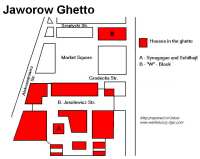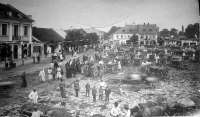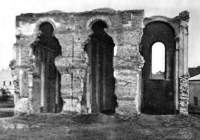 |
 |
 |
 |
 |
 |
 |
| Ghettos |
 |
The first atrocities against the Jews were organised here as early as September 1939. During the period of two weeks during which Jaworow was initially occupied by the Wehrmacht, the Germans, with the assistance of some Ukrainians, terrorized the Jews of the town. The main synagogue was burned down. Jews who were gathered around the synagogue had to sing religious songs whilst observing the burning synagogue. Many people were beaten in the streets. German soldiers cut the beards and carved swastikas on the heads of Orthodox Jews. During that time about 30 people were killed in Jaworow, mainly in accordance with a special list prepared by the Ukrainian mayor. At the end of September 1939, control of Jaworow passed to the Soviet Union, and the town remained under Soviet occupation until 22 June 1941. During the period of Soviet occupation, a group of Jewish refugees from the Generalgouvernement arrived in the town and the Jewish population increased to 3.000. The Soviets nationalized Jewish trade, and some wealthy Jews were persecuted on the grounds that they were "capitalists". The Soviets deported some of the Jewish refugees and many Poles from Jaworow to Siberia.
 |
| Jaworow * |
 |
| Market Square * |
The first staff of the Judenrat in Jaworow consisted of Sender Blum as the president, Salomon Henner, Leiser Wimmer, Munie Gils and Jakub Winter. Jaworow's Judenrat was also the regional Judenrat for the Jews of Krakowiec and Wielkie Oczy; however, there were also local Judenräte in these towns. The Judenrat in Jaworow was responsible from inception not only for contact with the German and Ukrainian authorities, but also for the conscription of Jews for labour a special office of the Jewish Arbeitsamt was organised and for the gathering of money and valuables for the Germans. Most of the Germans in the occupation administration were very corrupt individuals, and Jews had to pay "contributions" very frequently not only money but also furniture, clothes, shoes, etc. One contribution was organised solely for the gathering of all alcoholic drinks in the Jews' possession. Because Jews did not have much alcohol, the members of the Judenrat had to travel to Lwow to buy vodka and wine for the Germans. The principle person responsible for the official plunder of the Jews was Landkommissar Steyer from Grodek Jagiellonski. Every week he visited Jaworow with a group of Germans and ordered new contributions. The historian of the Jewish community in Jaworow described Steyer as insatiable in his demand for loot. He would force his way into Jewish homes, sweeping dishes from the table to the floor, smashing furniture and humiliating women. He flogged Ida Lipshitz. He ordered Polka Cipper to undress, ground her bare toes with his boots and whipped her mercilessly. He delighted in striking women with his bare fists until their blood flowed, and chasing them nude into the cold outdoors.
Although there was not initially a closed ghetto in Jaworow, Jews were not allowed to leave the town. The main problem for the Jews was the supply of food for their families. Jews started to sell the contents of their homes from the very beginning of the final German occupation. Poor people begged for food from the richer families, but even the richer families very quickly lost the opportunity to buy food. In 1941 many people died from starvation in Jaworow. Later the situation was to become much worse.
From autumn 1941, the Germans organised round-ups of Jews for work camps. The Judenrat was responsible for gathering young men for forced labour. A unit of the Jewish police, with Dawid Badian as its commander, was also established for this purpose. During the first "action", in deciding which young men should be sent to the work camps, the Judenrat selected mainly Jews from surrounding villages and towns. 200 men from Wielkie Oczy, Krakowiec and Jaworow were sent to the work camps in Winniki near Lwow and Jaktorow near Zloczow. The next "actions" were organised in January and May 1942. Because there were no longer any young men in the district, during the last "action" old men and boys were taken to the camps. In addition, some Jews from Jaworow were sent to the work camp at Janowska Road in Lwow. Jews from Jaworow incarcerated in these camps built the road from Lwow to Tarnopol. Many of them died in the camps or at their workplaces. In total, about 1,000 Jews from Jaworow and nearby towns were deported to the work camps. Having exhausted the labour pool in Jaworow, the German civil administrator of Lwow (Otto Bauer) requested that the chief of the SS and Police in Galicia district, Fritz Katzmann, arrange for the deportation from Jaworow of non-working Jews and their families because the administration was not prepared to supply them with food. The first resettlement was in fact not in Jaworow, but in Wielkie Oczy. On 10 June 1942, 247 Jews from this town (among them members of the Judenrat, together with their families) were resettled in Jaworow. Another group of about 200 people was resettled from Wielkie Oczy to Krakowiec.
In June 1942 Landkommissar Steyer ordered the Jews from Jaworow to destroy the town's Jewish cemetery. Every Jew from the town had to work at the cemetery demolishing graves and tombstones. Because of this "operation", on that same day the first President of the Jaworow Judenrat, Sender Blum, died of a heart attack in Steyer's office. The Landkommissar immediately decided that the next President of the Judenrat should be Dawid Badian, who had good relations with the Germans. Survivors from Jaworow professed a very bad opinion about the new President. He collaborated very closely with the Germans, was as corrupt, and was very cruel towards the Jews. Steyer personally related that he preferred Badian to the then Ukrainian mayor of Jaworow, Baczynski. A new commander of the Jewish police was also appointed at that time, the artist-painter Benio Haan. He was similarly considered to be a corrupt and cruel person.
 |
| Jaworow Synagogue * |
The day after the deportation the Germans ordered the establishment of a closed ghetto in Jaworow. The ghetto was located near the main synagogue and occupied a very small area. The Jews who survived the "action" had to settle in 80 houses on three streets; part of the market square, part of Aleksandrowicz Street and on the so-called "Schilhof", the part of the town where the synagogues were situated. At inception the closed ghetto contained 600-1,000 people. When Badian returned to Jaworow, the Germans once again appointed him to the position of President of the Judenrat. Haan, who had returned with him, remained the commander of the Jewish police. Altogether, 80 people who had jumped from the train to Belzec came back to the ghetto.
In mid-December 1942, the ghetto in Jaworow was designated as the main ghetto for the entire region. Jews from Krakowiec, Sadowa Wisznia, Grodek Jagiellonski, Mosciska, Ozomla, Twierdza, Krukienice, Szklo, and Bonow were resettled in Jaworow. The ghetto was not enlarged, and 5,000 people had to live together in the same 80 houses where no more than 1,000 had previously lived. Many Jews, especially those had no money to bribe the members of the Judenrat, had to spend several days on the streets. Later they were relocated to the building of the Beth-hamidrash, but in the meantime many children and old people were frozen to death.
Jonas Beer, a survivor from the Jaworow ghetto, described the conditions of the Jews at that time:
"There, like bees in a beehive, in terrible congestion, dirty, without water, clothes, linen, without food, in unspeakable fear and panic, Jews started their "new ghetto life". When somebody wanted to go to his former home to fetch necessities, he was shot in the street. Every day was more horrible and more overcrowded."
At the same time the members of the Judenrat and Jewish policemen lived in a separate house in very good conditions:
"While people lived in this squalor, the gentlemen from the Judenrat lived comfortably, even luxuriously. In pyjamas, in clean, beautiful linen, they played cards as if in the old good times. They lived lavishly. The denied themselves nothing, dressing elegantly."
There was also a café in the Judenrat building that served only the "elite" with the best alcohol and cakes. At the same time about 1,500 Jews in the ghetto died from starvation.
After the establishment of the ghetto, the Germans divided the Jews in Jaworow into two groups. A small group of 80 people marked with the letter "W" working for the Wehrmacht lived outside of the ghetto in a special block on the market square. They worked in the local Heeresamt and benefited from better conditions than the rest of the Jews in the ghetto. Among them were the men who began to organise a resistance movement. Another resistance group arrived in the ghetto in January 1943 from the liquidated ghetto of Lubaczow. Neither of these groups planned for armed resistance, but they prepared themselves for a mass escape at the moment of the ghetto's liquidation. Both groups bought weapons from Ukrainian policemen, and several days before the liquidation they escaped to the forest, where they organised a partisan unit.
The final liquidation of the ghetto in Jaworow took place on 16 April 1943. Before the liquidation, about 500 men were deported to the camp on Janowska Road in Lwow. During the liquidation of the ghetto, the SS set fire to houses that included shelters and bunkers containing hidden people. SS men and Ukrainian police shot whoever attempted to escape. Other people were gathered in the synagogue and after a selection, following which young men were sent to various work camps, the other people, mainly the elderly, women and children, were taken to the forest in Porudenko and were executed there. Many people were only wounded in the course of these shootings and were buried in mass graves while still alive. About 2,500 people were shot that day. Only the Jews from "W" block survived the liquidation, but two weeks later those who had not managed to escape from there were also shot.
Before the liquidation of the ghetto some people escaped from Jaworow to villages in the vicinity, where they tried to survive among Polish and Ukrainian peasants. On liberation, only 12 people from the Jewish community in Jaworow had survived. Others who had been in hiding were in many cases denounced, mainly by Ukrainians. Engineer Izrael Manber, one of the few survivors, described the situation of the hidden Jews:
"Most of the Ukrainians were cold and impassive. The Poles were more helpful. When Ukrainian Bandera partisans removed the Poles, the position of the Jews was hopeless. Mrs. Rath came back from the forest to Jaworow with her daughter. They looked for help from Professor Sadowski but they were arrested. The daughter committed suicide in prison and the mother was executed at the Jewish cemetery. When he found out about it, Mrs. Rath's husband also committed suicide...
Help from the Polish side could not be greater since the Poles were themselves a minority whose number had been further reduced because of Ukrainian attacks. Before the entry of the Soviet Army, the headquarters for Bandera units, which was located 2 km from Jaworow, gave an ultimatum to all Poles. They were to move from the region within a period of 5 days, so that the Poles had to look for hiding places as well...
Several days before the liberation, Ukrainians denounced Wiwakowna, who was hidden by Rozak, her Ukrainian fiancé. She was probably denounced by Rozak's brother. Wiwakowna, who was then pregnant, was shot by a German policeman at the Jewish cemetery."
After the liberation, the Soviet Commission for the Investigation of Nazi Crimes investigated the site of the mass execution in Porudenko forest. They found 4 mass graves there in which more than 2.500 people had been buried.
Photos:
http://fcit.coedu.usf.edu/ *
www.szukamypolski.com *
Sources:
Archive of the Jewish Historical Institute in Warsaw: Testimonies and memoirs by survivors.
T. Sandkühler: Endlösung in Galizien. Der Judenmord in Ostpolen und Rettungsinitiativen von Berthold Beitz 1941-1944, Bonn 1996.
K. D. Majus: Wielkie Oczy, Tel Aviv 2002.
Gilbert, Martin. The Holocaust The Jewish Tragedy, William Collins Sons & Co. Limited, London, 1986
 |
| 5,000 Jews lived in the ghetto |
© ARC 2005